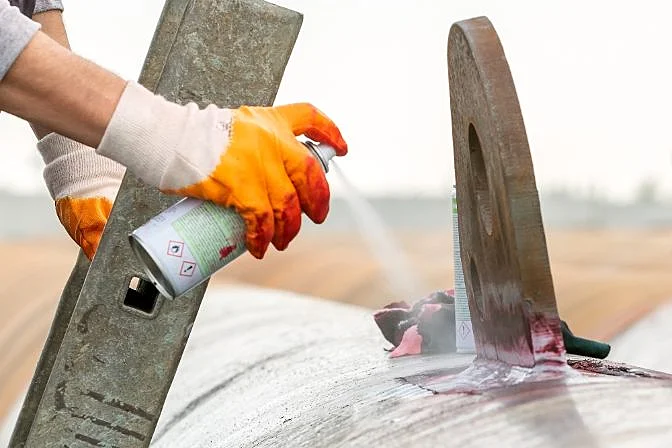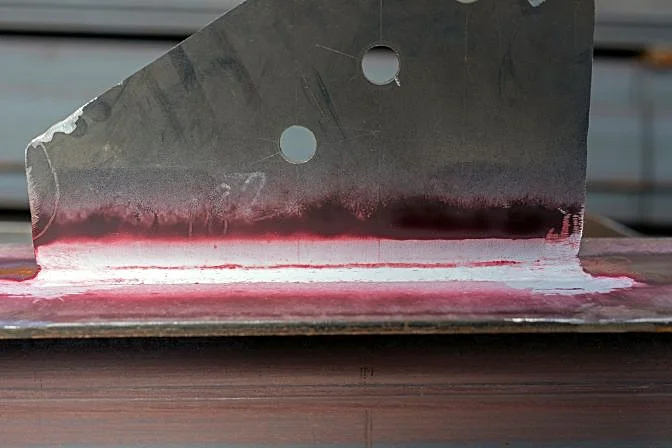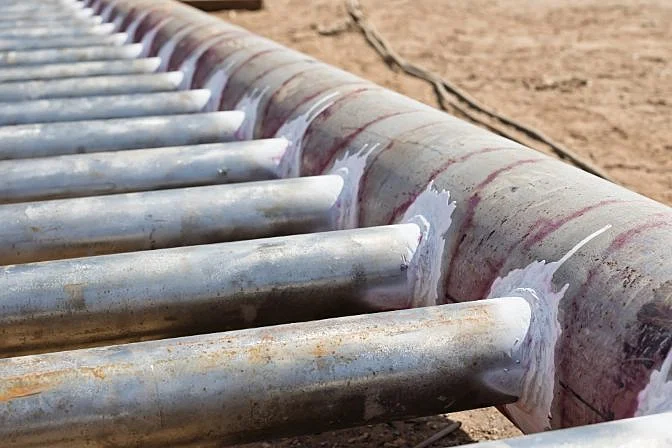What Is Dye Penetrant Testing?
Dye penetrant testing is a widely used non-destructive inspection technique that helps identify surface flaws in materials. It involves applying a special dye to the surface of an object, allowing it to seep into any cracks or discontinuities. After a certain period, excess dye is removed, and a developer is applied to draw out the dye from the flaws, making them visible to the inspector.
This method is also known as liquid penetrant testing, liquid dye penetrant testing, or simply penetrant testing. It is commonly referred to by several names, including dye penetrant inspection (DPI), liquid penetrant inspection (LPI), and liquid penetrant testing (LPT).
In this guide, we will use the terms "dye penetrant" and "liquid dye penetrant" interchangeably, as they are often used synonymously in the industry.
Dye penetrant testing is one of the most popular non-destructive testing (NDT) methods due to its simplicity, cost-effectiveness, and wide range of applications. It allows inspectors to examine surfaces without damaging the material, making it ideal for quality control and safety assessments.
[Dye penetrant NDT is just one of the many non-destructive testing (NDT) methods that inspectors use. Learn more about NDT in this in-depth guide.]

Understanding Dye Penetrant Testing
Dye penetrant testing is primarily used to detect surface defects such as cracks, porosity, and leaks in various types of materials. It is especially effective on non-porous surfaces made from metals, plastics, and ceramics.
The process relies on capillary action, where the dye flows into small openings on the surface. Once the dye has had time to penetrate, it is removed from the surface, and a developer is applied. The developer draws the dye back to the surface, making any defects clearly visible.
This testing method is frequently used in industries such as aerospace, automotive, and manufacturing to ensure the integrity of components like welds, castings, forgings, pipes, and plates.
Historically, dye penetrant testing was first introduced in the railroad industry in the early 1900s. Initially, it involved using oil and whiting to detect cracks. Over time, the method evolved, and dyes were added to enhance visibility, leading to the modern techniques used today.

Advantages and Disadvantages of Dye Penetrant Testing
Dye penetrant testing is a popular choice among inspectors because it is straightforward, cost-effective, and can be performed with minimal equipment. However, it also has some limitations.
Pros:
- Easy to perform on complex shapes and surfaces
- Low cost compared to other NDT methods
- Can inspect large areas quickly
- Defects are visible to the naked eye or under UV light
- Works on a variety of materials, including ferrous and non-ferrous metals
Cons:
- Only detects surface-breaking flaws
- Cannot be used on porous materials
- Requires clean, uncoated surfaces
- Needs direct access to the area being tested
- Multiple steps are involved, which can affect accuracy
- Chemicals are used, requiring proper handling and disposal
The Dye Penetrant Testing Procedure
Inspectors typically follow six main steps when conducting a dye penetrant test:
1. Surface Preparation
The surface must be thoroughly cleaned to remove dirt, oil, paint, or any contaminants that could interfere with the test. Common cleaning methods include solvent wiping, vapor degreasing, or mechanical cleaning like grinding or brushing.
2. Apply the Penetrant
A specially formulated dye is applied to the surface, either by spraying or brushing. The penetrant is left to dwell for a specified time, usually between 5 to 20 minutes, depending on the product instructions.
3. Remove Excess Penetrant
After the dwell time, any excess penetrant is wiped off using a dry cloth. A remover may also be used to clean the surface before applying the developer.
4. Apply the Developer
A white developer is applied to the surface, which draws the penetrant from any cracks or flaws, making them visible. The developer enhances contrast and makes it easier to spot defects.
5. Inspection
Inspectors examine the surface under normal or ultraviolet lighting, depending on whether a visible or fluorescent penetrant was used. Visible dyes are seen under regular light, while fluorescent dyes require UV light for visibility.
6. Clean the Surface
Once the inspection is complete, the surface is cleaned to remove any remaining penetrant and developer, restoring it to its original condition.

Selecting the Right Penetrants, Removers, and Developers
Inspectors have a variety of options for each stage of the process, including different types of penetrants, removers, and developers. These choices depend on the material being tested, the environment, and the level of detail required.
Penetrant Types:
- Color contrast
- Fluorescent
- Combination (color and fluorescent)
Remover Types:
- Solvent-based
- Post-emulsifiable
- Water-soluble
- Water-suspendable
Developer Types:
- Dry powder
- Aqueous
- Non-aqueous
Each combination offers unique benefits, and the selection should be based on the specific requirements of the inspection.
Standards and Codes for Dye Penetrant Testing
Dye penetrant testing is often used in both general and code-compliant inspections. While it’s relatively simple and inexpensive, it still requires adherence to specific standards, especially in regulated industries.
Some of the most commonly referenced standards include:
ASTM Standards
- ASTM E 165: Standard Practice for Liquid Penetrant Examination for General Industry
- ASTM E 1417: Standard Practice for Liquid Penetrant Testing
- ASME BPVC, Section V, Article 6: Liquid Penetrant Examination
- ASME BPVC, Section V, Article 24: Standard Test Method for Liquid Penetrant Examination SE-165
ISO Standards
- ISO 3452-1: Non-destructive testing - Penetrant testing - Part 1: General principles
- ISO 3452-2: Non-destructive testing - Penetrant testing - Part 2: Testing of penetrant materials
- ISO 3452-3: Non-destructive testing - Penetrant testing - Part 3: Reference test blocks
- ISO 3452-4: Non-destructive testing - Penetrant testing - Part 4: Equipment
- ISO 3452-5: Non-destructive testing - Penetrant testing - Part 5: Penetrant testing at temperatures higher than 50°C
- ISO 3452-6: Non-destructive testing - Penetrant testing - Part 6: Penetrant testing at temperatures lower than 10°C
- ISO 3059: Non-destructive testing - Penetrant testing and magnetic particle testing - Viewing conditions
- ISO 12706: Non-destructive testing - Penetrant testing - Vocabulary
- ISO 23277: Non-destructive testing of welds - Penetrant testing of welds - Acceptance levels
CEN Standards
- EN 1371-1: Founding - Liquid penetrant inspection - Part 1: Sand, gravity die and low pressure die castings
- EN 1371-2: Founding - Liquid penetrant inspection - Part 2: Investment castings
- EN 10228-2: Non-destructive testing of steel forgings - Part 2: Penetrant testing
- EN 10246-11: Non-destructive testing of steel tubes - Part 11: Liquid penetrant testing of seamless and welded steel tubes for the detection of surface imperfections
For more information on these standards, visit the official websites of the organizations responsible for their development, such as ASTM, ISO, and ASME.
Defoamer for coating -series:
Leveling agent for coating-series
Wetting dispersant and substrate wetting agent
leveling agent, feeling agent
Carbon hydroxyl modified silicone oil, feeling agent,
UV curing anti-graffiti, anti-pollution agent
Defoamer, Coating leveling Agent, defoaming agent,Wetting and leveling agent, Wetting dispersant, Substrate wetting agent,feeling agent
Changzhou Dahua-Luckypower , https://www.czluckypowertech.com
